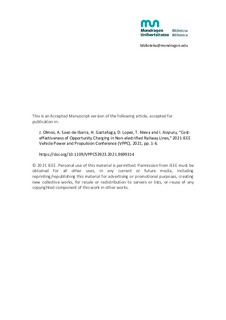
Izenburua
Cost-effectiveness of Opportunity Charging in Non-electrified Railway LinesEgilea
Egilea (beste erakunde batekoa)
Ikerketa taldea
Almacenamiento de energíaSistemas electrónicos de potencia aplicados al control de la energía eléctrica
Beste instituzio
IkerlanConstrucciones y Auxiliar de Ferrocarriles (CAF)
Bertsioa
Postprinta
Eskubideak
© 2021 IEEESarbidea
Sarbide irekiaArgitaratzailearen bertsioa
https://doi.org/10.1109/VPPC53923.2021.9699314Non argitaratua
2021 IEEE Vehicle Power and Propulsion Conference (VPPC) 25-28 de Octubre 2021Argitaratzailea
IEEEGako-hitzak
lithium-ion batteries
Costs
Sensitivity analysis
Conferences ... [+]
Costs
Sensitivity analysis
Conferences ... [+]
lithium-ion batteries
Costs
Sensitivity analysis
Conferences
Mechanical power transmission
Propulsion
Rail transportation [-]
Costs
Sensitivity analysis
Conferences
Mechanical power transmission
Propulsion
Rail transportation [-]
Laburpena
This paper analyses the cost-effectiveness of deploying opportunity charging points in long-distance non-electrified railway lines, which are driven by battery-based hybrid diesel-electric railway veh ... [+]
This paper analyses the cost-effectiveness of deploying opportunity charging points in long-distance non-electrified railway lines, which are driven by battery-based hybrid diesel-electric railway vehicles. A study case based on a real railway line is presented, where potential locations for the charging points are proposed. With the aim of developing a comprehensive sensitivity analysis, for each combination of charging points locations the life cycle costs of different energy management strategies and lithium-ion battery technologies are also compared. Additionally, for each case the optimal size of the powertrain elements is calculated. In order to develop the proposed analysis, a methodology based on an optimization approach is presented. The obtained results demonstrate that deploying opportunity charging points along the route is a feasible solution, as long as appropriate strategies and battery technologies are used. In the best scenario, the life cycle cost of a base case without charging points can be reduced a 4.3%, and the cost of a traditional diesel-electric vehicle a 7.6%. [-]





















